Bluebirds are an important species in California and have a long history of inhabiting the state. They have been around since the early days of California’s settlement, and are an important part of its wildlife and ecology.
Bluebirds are a vibrant and cheerful sight in the sky and can be seen all across California. These birds are often seen in open fields, woodlands, and even urban areas. They are active during the day and can be seen perched on tree branches, flying, and foraging for food.
The bluebird population in California is healthy and stable, making them a welcomed sight in the state.
1. Western Bluebird
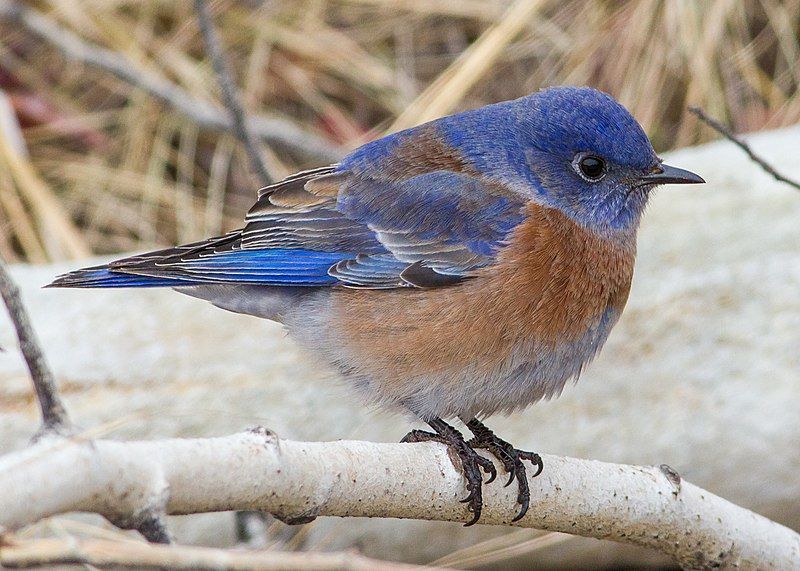
The western bluebird is a species of thrush, native to North America. It is a small bird, measuring around 6-7 inches in length, and weighing between 1-2 ounces. Its back and wings are mostly blue, with its breast and belly feathers being a bright reddish-orange.
Its eye is black, its bill is short and stubby, and its legs are dark gray. Western bluebirds prefer to live in open woods, meadows, and grasslands. They feed mainly on insects, but will also eat berries and small fruits.
During the breeding season, they build their nests in trees, fences, and buildings.
The female is responsible for incubating the eggs, while the male will bring food to the female and watch over the nest. Western bluebirds are also known to migrate during the winter, heading south to avoid the colder temperatures.
They have been known to form large flocks and travel together in search of food. Western bluebirds are considered to be a beneficial species, as they help to eliminate harmful insects from the environment.
They are also an important contributor to the economy, as they are frequently hunted for their feathers which are used to make clothing, hats, and other items. Overall, the western bluebird is a beautiful and important species that deserves to be protected and appreciated.
| Kingdom | Animalia |
| Phylum | Chordata |
| Class | Aves |
| Order | Passeriformes |
| Family | Turdidae |
| Genus | Sialia |
| Species | S. mexicana |
2. Mountain Bluebird
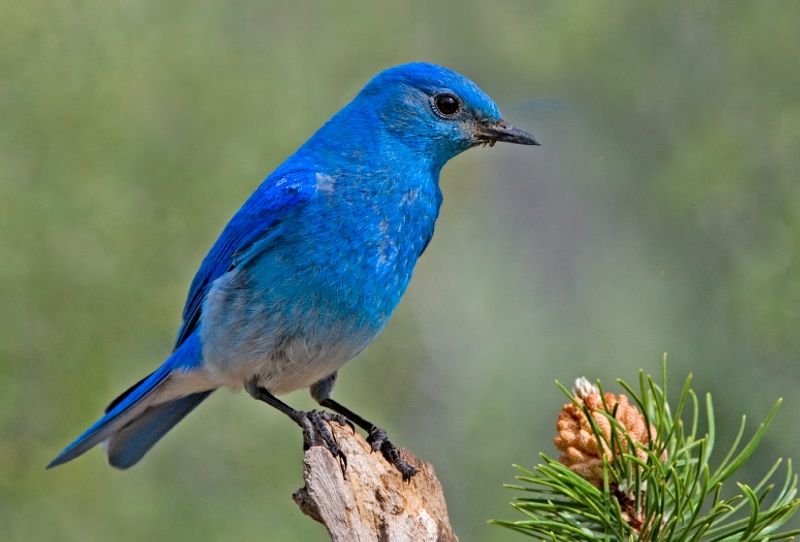
The mountain bluebird is a small thrush that migrates between western North America’s mountainous districts. It has a light underbelly and black eyes, and adult males have thin bills that have a bright turquoise-blue hue.
The males also have a lighter coloration on their underside. This species of bird can be found in the western states of North America, from Alaska to New Mexico, and it prefers open, grassy areas, or areas with sparse tree growth.
Mountain bluebirds often inhabit high-altitude meadows and canyons, and they have even been observed at elevations of over 10,000 feet. They feed mainly on insects, which they catch by flying from high perches and swooping down on their prey.
The mountain bluebird is an attractive bird, with its bright blue plumage and its contrasting light-colored underside. It is considered to be a symbol of happiness and good fortune, and it is a popular bird for birdwatchers.
| Kingdom | Animalia |
| Phylum | Chordata |
| Class | Aves |
| Order | Passeriformes |
| Family | Turdidae |
| Genus | Sialia |
| Species | S. currucoides |
3. California Scrub Jay
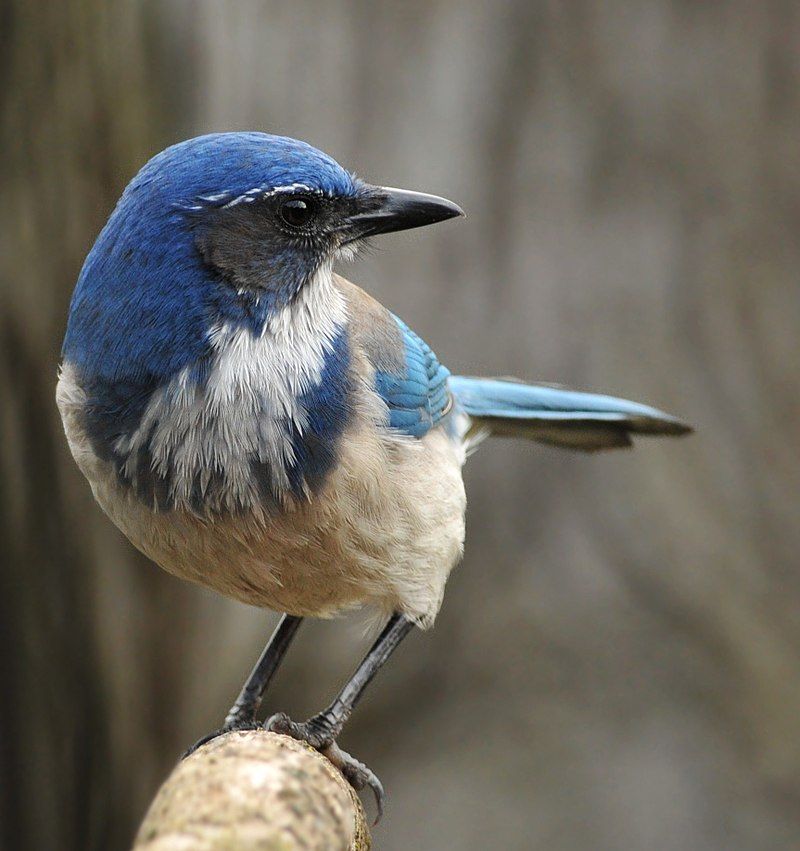
The California scrub jay is a species of bird that is native to western North America. It is found in a wide range of habitats, from British Columbia in the north, all the way down to California and parts of western Nevada near Reno, and even to the west of the Sierra Nevada.
The California scrub jay is one of the most adaptable birds in its range, being able to thrive in a variety of different environments. It is a medium-sized bird, with a rather large head and a long, slightly curved bill.
Its plumage is a mix of grey, blue, and brown, with a white streak on its forehead. It is known for its intelligence and social behavior, living in groups of up to fifteen birds, and engaging in cooperative behaviors such as feeding and mobbing predators.
It is also known for its loud, harsh call, which can be heard over long distances.
| Kingdom | Animalia |
| Phylum | Chordata |
| Class | Aves |
| Order | Passeriformes |
| Family | Corvidae |
| Genus | Aphelocoma |
| Species | A. californica |
4. Barn Swallow
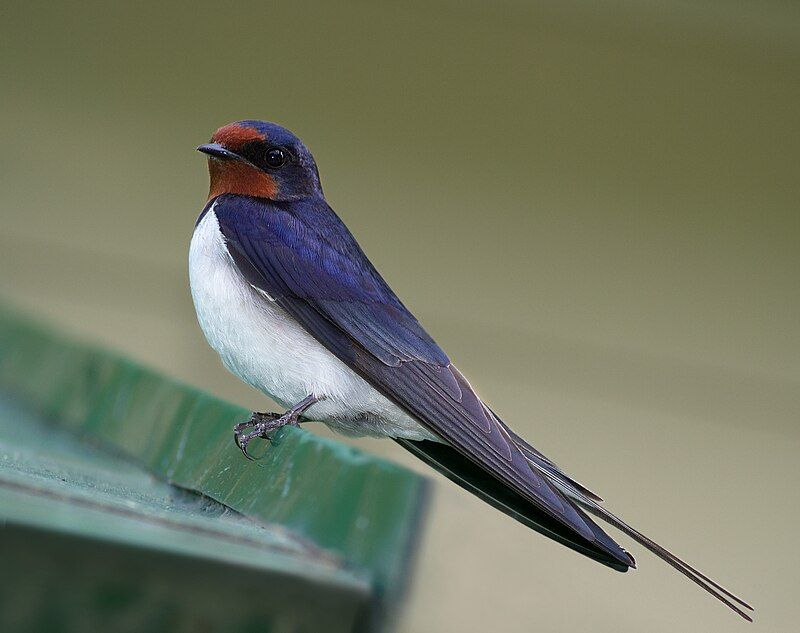
The barn swallow is an amazing bird species that is found all around the world. It has the largest natural distribution of any of the world’s passerines, meaning that it can be found in an incredible 251 million square kilometers.
This makes the barn swallow one of the most common species of birds in the world. The barn swallow is easily recognizable due to its distinct features. It has deep blue upperparts and a long, forked tail.
The forked tail is a trademark trait of barn swallows and helps them to fly and maneuver better when catching insects in mid-air.
The deep blue of its feathers also helps it stand out against the sky, making it easy to spot in flight. The barn swallow’s wide distribution and adaptability have helped it become one of the most successful species of bird in the world.
It can be found in a variety of habitats, including grasslands, wetlands, and open woodlands, and it is capable of surviving in many different climates.
Its ability to thrive in different conditions has allowed it to maintain its large range. The barn swallow is a remarkable species, and its wide distribution and adaptability are a testament to its success.
It is a fitting symbol of the world’s beauty and diversity, and it is an important part of the natural world.
| Kingdom | Animalia |
| Phylum | Chordata |
| Class | Aves |
| Order | Passeriformes |
| Family | Hirundinidae |
| Genus | Hirundo |
| Species | H. rustica |
5. Steller’s Jay
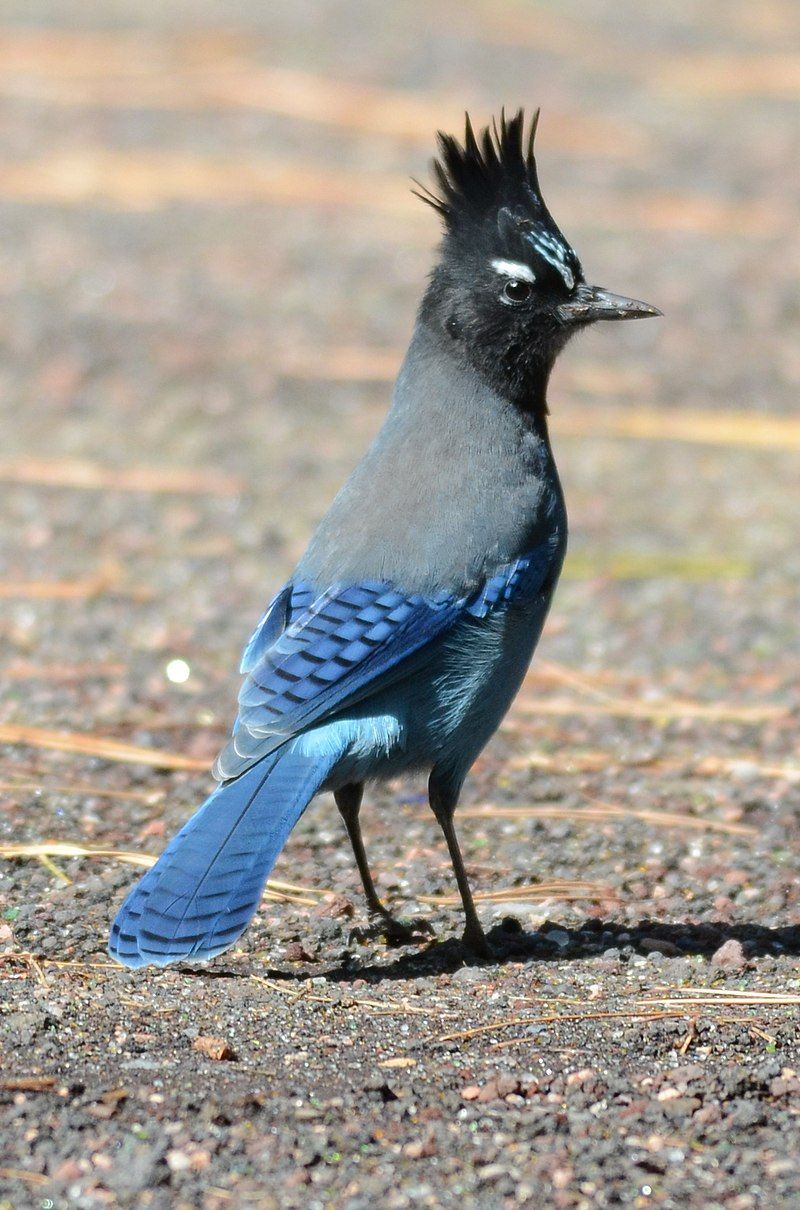
Steller’s jay is a striking black and blue bird that is native to western North America and the mountains of Central America. It is closely related to the blue jay, which is found in eastern North America.
This species of jay is distinct in that it is the only crested jay found west of the Rocky Mountains. The bird is known for its bright blue wings and tail, with a black head, neck, and back. It has a white chest and belly, and a black crest on its head.
The Steller’s jay has a loud, harsh call which is often heard in the forests they inhabit. This species is also a very social bird, often seen in groups of up to 30 individuals. They are omnivorous, feeding on a variety of nuts, fruits, insects, and even carrion.
Steller’s jays are highly adaptable to changing environments and are often seen near human dwellings.
| Kingdom | Animalia |
| Phylum | Chordata |
| Class | Aves |
| Order | Passeriformes |
| Family | Corvidae |
| Genus | Cyanocitta |
| Species | C. stelleri |
6. Lazuli Bunting
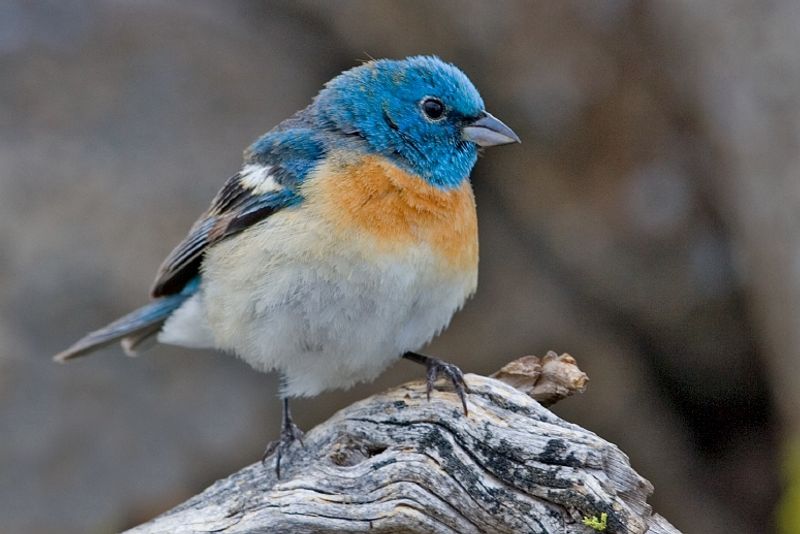
The lazuli bunting is a small, brightly-colored songbird native to North America. Its name is derived from the gemstone lapis lazuli, due to its striking blue plumage. The male of the species is a vivid blue, while the female is a muted brown.
Their diet consists of insects, seeds, and berries. They are often found in open woodlands, mountain meadows, and shrublands. During the fall and winter, the lazuli bunting migrates south to Mexico and Central America.
The species is considered to be of least concern by the International Union for Conservation of Nature. However, due to habitat loss and destruction, the population size is decreasing, and the species is now considered to be vulnerable.
| Kingdom | Animalia |
| Phylum | Chordata |
| Class | Aves |
| Order | Passeriformes |
| Family | Cardinalidae |
| Genus | Passerina |
| Species | P. amoena |
7. Blue Grosbeak
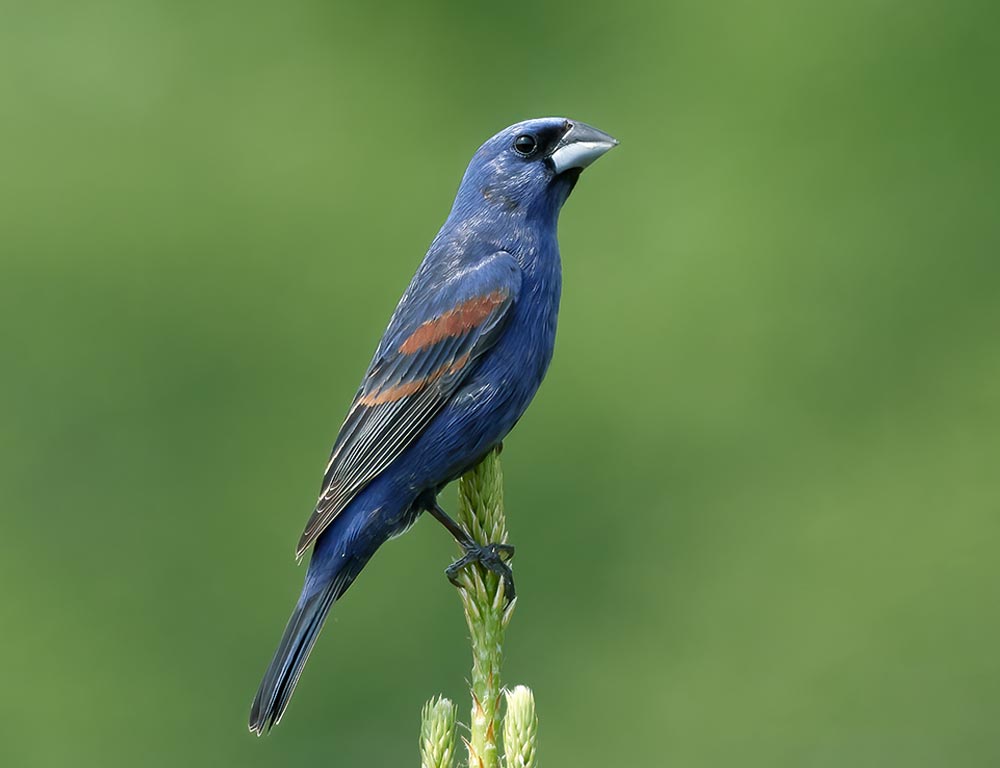
The blue grosbeak is a type of bird native to parts of North America, belonging to the family of birds known as Cardinalidae. It is a medium-sized bird, typically measuring around 8.5 inches in length.
The male is a striking blue color with two brown wing bars, while the female is primarily brown and gray. The blue grosbeak is mainly migratory, spending winters in Central America and breeding in northern Mexico and the southern United States during the summer months.
Its diet consists of a variety of seeds, insects, and fruits. It is also a popular target of birdwatchers, as its bright blue feathers make it a striking sight in its natural habitat.
| Kingdom | Animalia |
| Phylum | Chordata |
| Class | Aves |
| Order | Passeriformes |
| Family | Cardinalidae |
| Genus | Passerina |
| Species | P. caerulea |
8. Tree Swallow
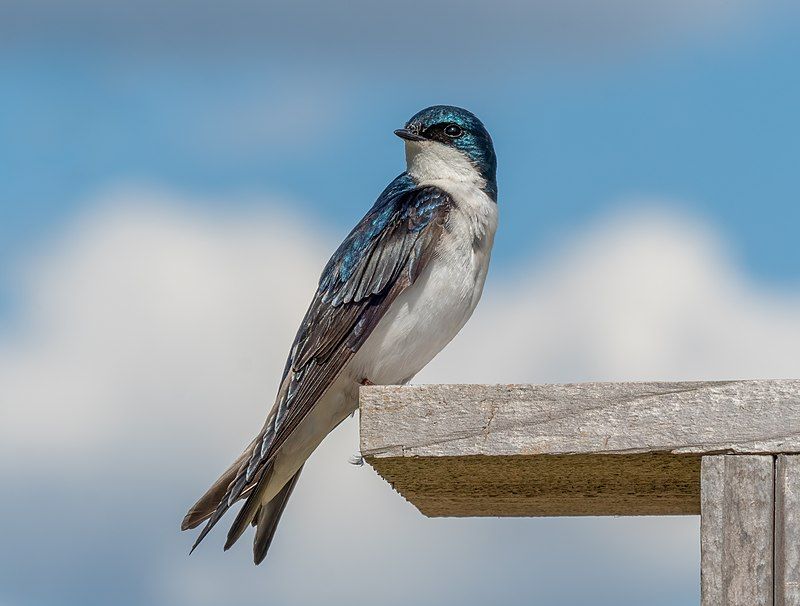
The tree swallow is a type of migratory bird belonging to the Hirundinidae family. It is found in the Americas and was first described in 1807 by French ornithologist Louis Vieillot. It has since been classified in its genus, called Tachycineta.
This classification has been the source of debate among experts, as the exact phylogenetic placement of the tree swallow is not fully understood. The tree swallow is a small bird, usually around 13-16 cm in length. Its wingspan can range from 19 to 22 cm.
It has a blue-green upper body, with a white underbelly and wings. It also has a small black spot at the base of its tail. Tree swallows are usually seen in open fields and meadows, where they feed on insects like flies, bees, and moths.
They perch on trees and wires and are quite active during the day. During the breeding season, the males build a nest in a tree or on a building.
The females lay up to six eggs, which they incubate for 12-14 days. Tree swallows are migratory birds, which means they migrate to warmer areas during the winter months. They usually fly south in large flocks, often as far as Central America.
In the spring, they return to their breeding grounds. The tree swallow is an important species in the Americas, as it plays an important role in the food chain and the ecosystem. It is also an important source of food for other birds and animals.
Unfortunately, this species is threatened by climate change, habitat loss, and pesticides. Conservation efforts are needed to ensure its future.
| Kingdom | Animalia |
| Phylum | Chordata |
| Class | Aves |
| Order | Passeriformes |
| Family | Hirundinidae |
| Genus | Tachycineta |
| Species | T. bicolor |
9. Aphelocoma
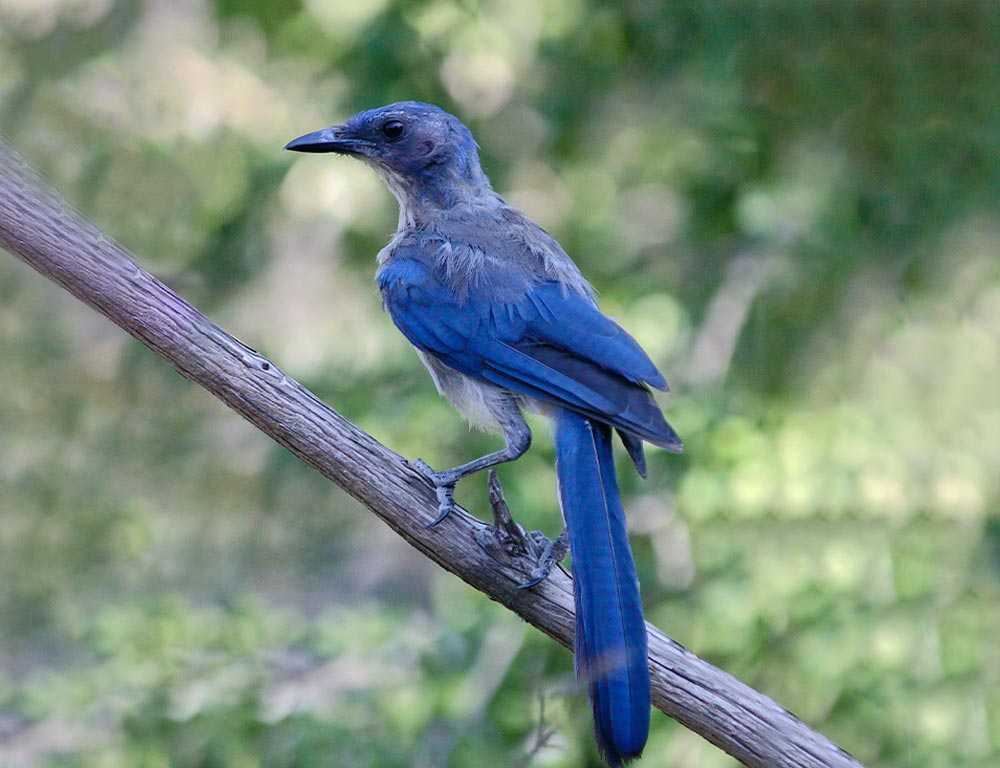
The passerine birds of the genus Aphelocoma are a type of New World jay found in North America. These birds are commonly known as scrub jays and their relatives.
They are found in Mexico, western Central America, and the western United States, with an outlying population in Florida. Scrub jays are medium-sized birds, between seven and nine inches long from head to tail. They have long legs and a long, stout bill.
Their plumage ranges from greyish-blue to greyish-brown, with a white breast and belly. Many species have a distinctive bright blue patch on their wings and tail. Scrub jays are omnivores, eating a variety of fruits, nuts, and insects.
They are also known to store food in caches and to steal food from other birds. They are typically found in open woodlands, scrublands, and grasslands. Scrub jays are known for their intelligence and complex social behavior.
They are very vocal and can recognize individual humans and other birds. They are also known to form social bonds with other jays. The passerine birds of the genus Aphelocoma are an important part of the avian community in North America.
They are valuable for their beauty, intelligence, and social behavior.
| Kingdom | Animalia |
| Phylum | Chordata |
| Class | Aves |
| Order | Passeriformes |
| Family | Corvidae |
| Genus | Aphelocoma |
10. Island Scrub Jay

The island scrub jay is a species of bird belonging to the Aphelocoma genus that is native to Santa Cruz Island, located off the coast of Southern California.
This species is unique in that it is the only breeding bird species native to the continental United States and Canada that is restricted to a single island. It is also known as the island jay or Santa Cruz jay.
The island scrub jay is a medium-sized bird with a grey-blue head, chest, and wings, and a lighter grey-brown back and tail. It typically lives in chaparral, coastal scrub, and oak woodlands habitats.
It mainly feeds on insects and small vertebrates, but also eats some fruits and nuts.
The island scrub jay is listed as a threatened species under the Endangered Species Act due to its limited range and the threat of habitat destruction from fire suppression, non-native species, and recreational activities.
Conservation efforts have been undertaken to protect this species, such as controlling invasive species and restoring habitat. It is also protected by the Migratory Bird Treaty Act.
| Kingdom | Animalia |
| Phylum | Chordata |
| Class | Aves |
| Order | Passeriformes |
| Family | Corvidae |
| Genus | Aphelocoma |
| Species | A. insularis |
11. Thrush
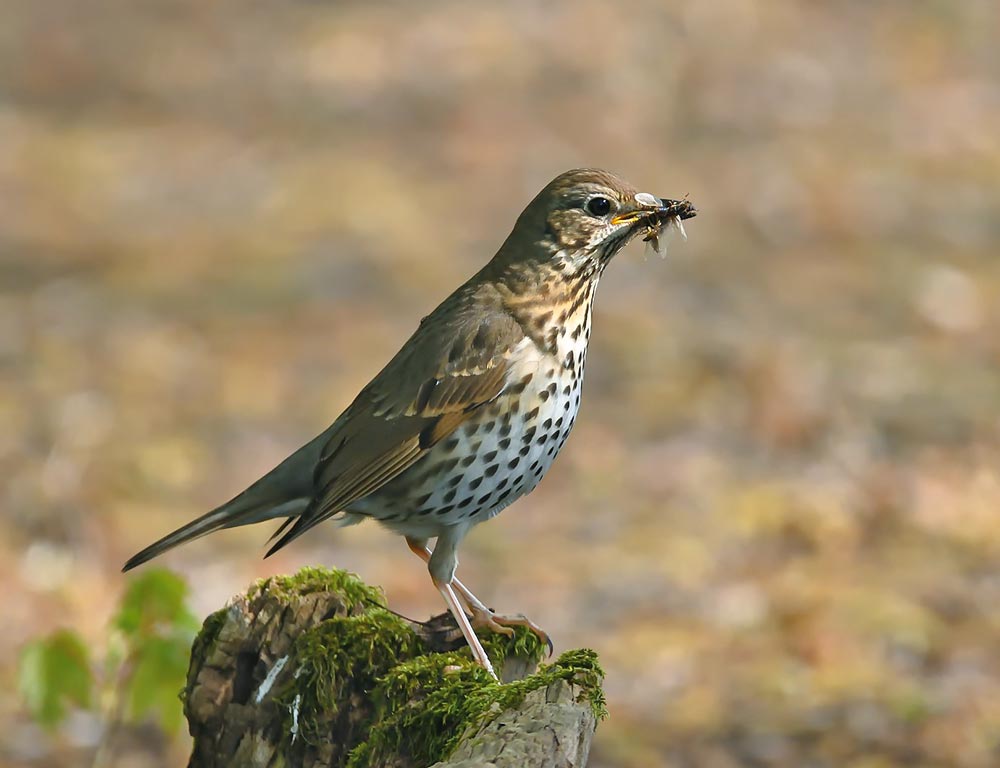
The thrushes are a type of bird in the family Turdidae which can be found all around the world. This family used to be much bigger, containing birds known as chats and European robins, however, biologists have now reclassified them as Old World flycatchers.
This means that the thrushes are now their own distinct family, and the chats and European robins have been moved to another group. The thrush family is a diverse one, containing species such as the bluebird, the American robin, the song thrush, the fieldfare, and the blackbird.
All of these birds have a variety of characteristics that make them unique, such as different beak and feather colors, as well as different sizes and shapes.
The thrush family is important to the environment, as it helps to keep the populations of insects, worms, and other small animals in check. By eating these animals, the thrushes keep their numbers under control and also provide an important source of food for other animals.
The reclassification of the former subfamily Saxicolinae has helped to make the thrush family more distinct, and it has also allowed biologists to better understand the different types of birds that belong to this family.
By understanding the thrushes better, biologists can better protect them and ensure that their populations remain healthy and robust.
| Kingdom | Animalia |
| Phylum | Chordata |
| Class | Aves |
| Order | Passeriformes |
| Family | Turdidae |
12. Blue-Gray Gnatcatcher
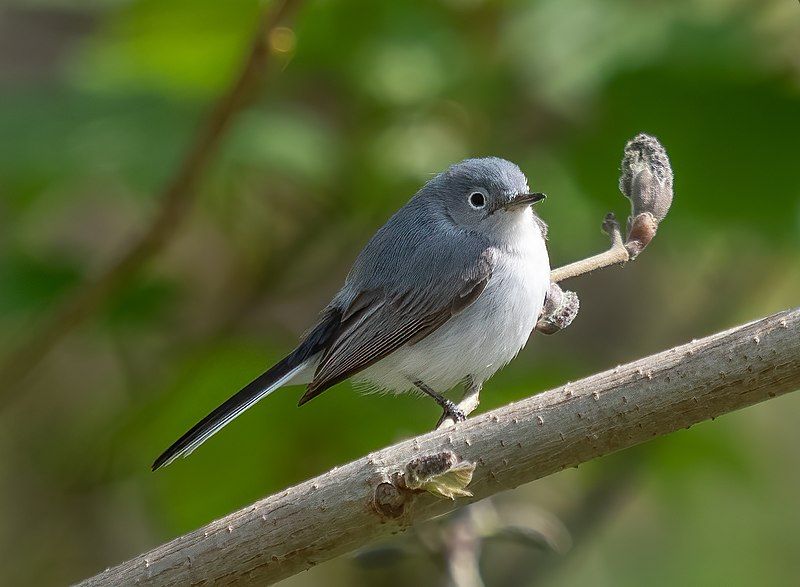
The blue-gray gnatcatcher is a species of songbird native to North America. It is a small bird, usually only reaching sizes of around four inches in length. Its plumage is predominantly blue-gray, although some specimens may also feature spots of white or brown.
The gnatcatcher is known for its energetic and active behavior, often seen flitting around in trees or flying low over open fields.
It feeds on a variety of insects, including gnats, flies, and other small invertebrates. The blue-gray gnatcatcher is found in a variety of habitats, ranging from wooded and wetland areas to open grassland and shrubland.
It has a wide range throughout the United States and Canada, as well as parts of Mexico. During the breeding season, it may form small colonies with other gnatcatchers, though it is usually solitary or in pairs during the winter.
The blue-gray gnatcatcher is a common bird in many areas, although its population numbers have been declining in recent years due to habitat destruction.
| Kingdom | Animalia |
| Phylum | Chordata |
| Class | Aves |
| Order | Passeriformes |
| Family | Polioptilidae |
| Genus | Polioptila |
| Species | P. caerulea |
13. Purple Martin

The purple martin is a type of passerine bird found in the swallow family Hirundinidae. It is the largest swallow species in North America and can be found in both open and wooded areas. Despite its name, the purple martin does not have any purple feathers.
Instead, its feathers are mostly black and blue. The purple in its name likely comes from the glossy sheen of its feathers in the sunlight. The purple martin is a popular species among birders, as it is known to be quite social and often nests in colonies.
It breeds across much of the United States and Canada and migrates south to Central and South America in the winter. The purple martin is an important species for insect control, as it eats large numbers of insects such as flies, moths, and beetles.
It is also important to humans as a symbol of summer, as its presence in the late spring and summer is a welcome sign of warmer days to come.
| Kingdom | Animalia |
| Phylum | Chordata |
| Class | Aves |
| Order | Passeriformes |
| Family | Hirundinidae |
| Genus | Progne |
| Species | P. subis |
14. Great Blue heron
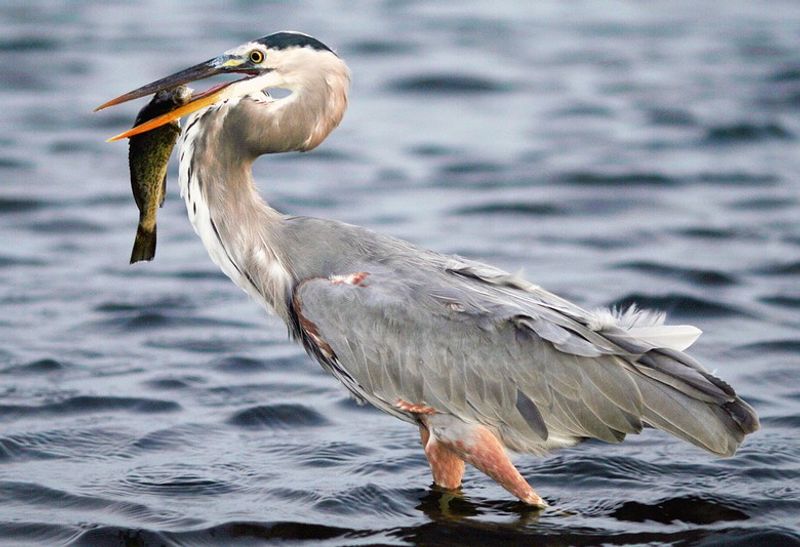
The great blue heron is a majestic bird that is found in a variety of habitats across much of the Americas.
It is a member of the heron family Ardeidae and can be spotted near the coastline of the many bodies of water that exist in North and Central America, as well as far northwestern South America, the Caribbean, and the Galápagos Islands.
It is a large wading bird that is often seen gracefully stalking its prey in the shallows. It is a solitary hunter and often remains motionless for long periods waiting for the perfect opportunity to strike.
Its long legs and neck allow it to wade through the water looking for food, while its large wingspan allows it to fly long distances in search of food or a new home.
The great blue heron is a fascinating species, and its adaptability to many different habitats makes it a species to be admired.
| Kingdom | Animalia |
| Phylum | Chordata |
| Class | Aves |
| Order | Pelecaniformes |
| Family | Ardeidae |
| Genus | Ardea |
| Species | A. herodias |
15. Little Blue Heron

The little blue heron is a species of heron found in the genus Egretta and is recognizable due to its small size and darkly colored feathers. It has a two-toned bill, usually a dark color at the tip and a lighter color near the base.
Juveniles of this species are entirely white, giving them a similar appearance to the snowy egret. During the breeding season, adults of this species develop different coloration on their head, legs, and feet.
This color change is thought to be triggered by hormones released during this time of year and serves as a way for the heron to make itself more visible and attractive to potential mates.
| Kingdom | Animalia |
| Phylum | Chordata |
| Class | Aves |
| Order | Pelecaniformes |
| Family | Ardeidae |
| Genus | Egretta |
| Species | E. caerulea |
16. Florida Scrub Jay
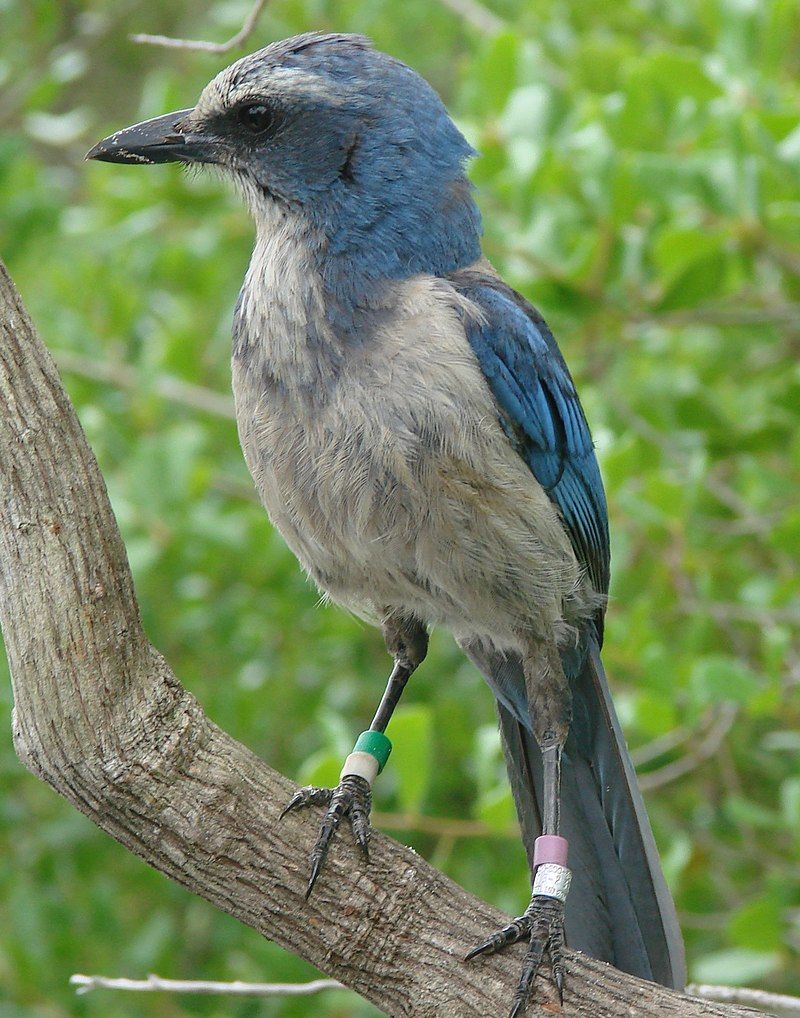
The Florida scrub jay is a species of scrub jay found exclusively in North America. It is the only bird species endemic to the state of Florida, meaning it can not be found anywhere else in the United States.
This makes it highly sought after by birders, or people who observe and collect information about birds. The Florida scrub jay is one of fifteen species of birds that are endemic to the continental United States, making it a rare find for birders.
Its range is limited to the peninsula of Florida, with some populations extending into the panhandle. The bird is primarily a ground feeder, and can often be found in the open areas of scrub and pine flatwoods. It also feeds on insects, acorns, berries, and other small items.
The Florida scrub jay is an important species for conservation, as it is an indicator species for the health of the scrub ecosystem. Protecting its habitat is essential for its survival and the survival of other species that depend on the scrub ecosystem.
| Kingdom | Animalia |
| Phylum | Chordata |
| Class | Aves |
| Order | Passeriformes |
| Family | Corvidae |
| Genus | Aphelocoma |
| Species | A. coerulescens |
17. Common Starling
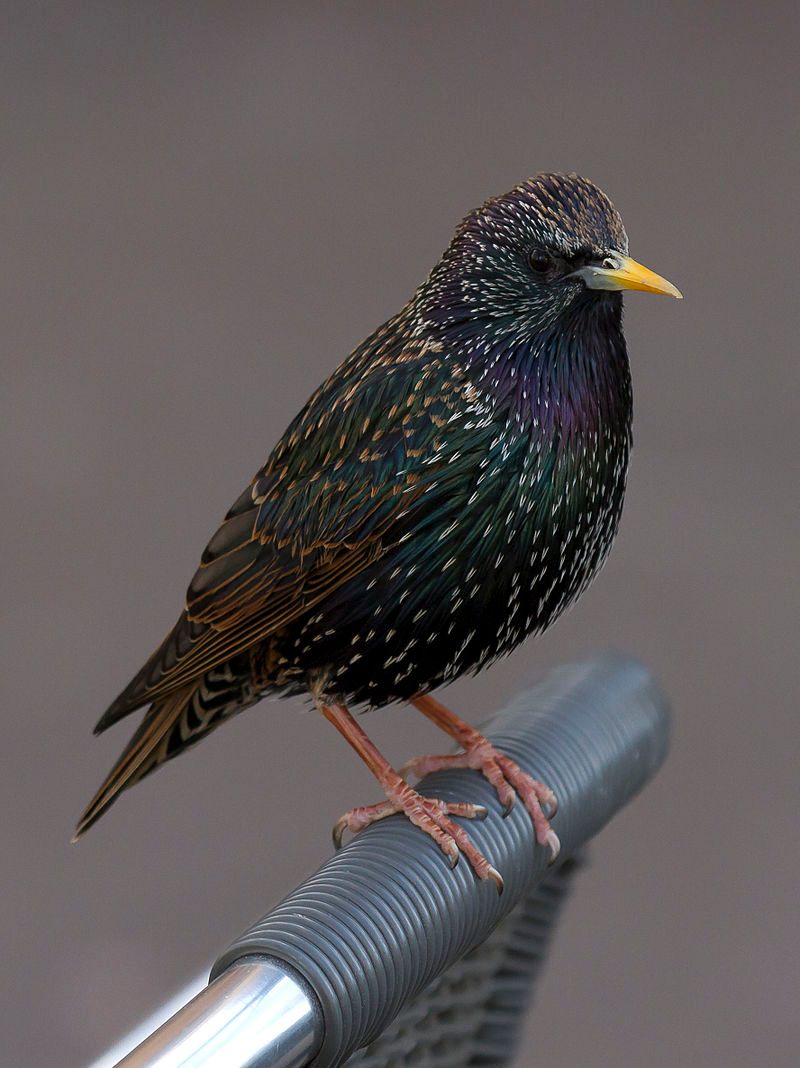
The common starling is a widespread bird, found across Europe, North America, and parts of Asia. It is a member of the Sturnidae family of birds, which includes other starling species like the spotless starling and the common myna.
The common starling is a medium-sized passerine bird, meaning it belongs to the order of birds which includes finches, sparrows, and other small, perching birds. It is stocky and has a short, rounded neck, a short, thick bill, and a short, rounded tail.
It is usually glossy black with a metallic sheen, although some specimens have white spots or streaks. The common starling is known by different names in different countries.
In North America, it is called the European starling, while in Great Britain and Ireland, it is simply known as the starling.
| Kingdom | Animalia |
| Phylum | Chordata |
| Class | Aves |
| Order | Passeriformes |
| Family | Sturnidae |
| Genus | Sturnus |
| Species | S. vulgaris |
18. Common Grackle
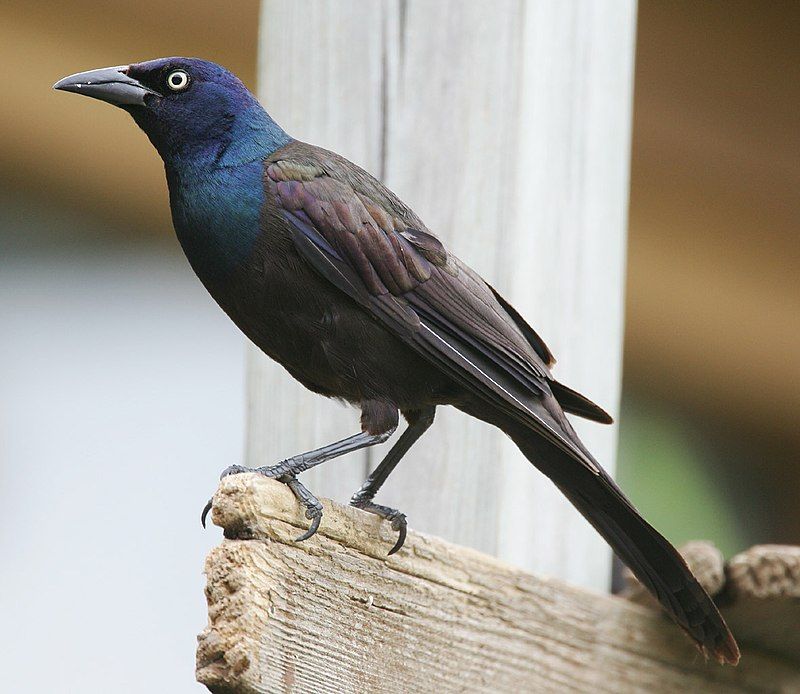
The common grackle is a species of large icterid bird that can be seen in large numbers across much of North America. It was first described by Swedish Naturalist Carl Linnaeus in 1758. The common grackle has three subspecies, all of which have distinct characteristics.
Adult common grackles have long and dark bills, pale yellow eyes, and long tails. They are usually found in wooded areas, parks, and open fields, where they feed on seeds, fruits, insects, small invertebrates, and even small vertebrates.
They have a varied diet and are known to be omnivorous. Common grackles are known to be highly social birds and are often seen in large flocks. They are also capable of mimicking the sounds of other bird species, as well as human speech.
Common grackles have many predators, including hawks, owls, foxes, and cats. This species has adapted to human presence and can be seen near cities, farms, and even residential areas.
| Kingdom | Animalia |
| Phylum | Chordata |
| Class | Aves |
| Order | Passeriformes |
| Family | Icteridae |
| Genus | Quiscalus |
| Species | Q. quiscula |
19. Mexican Jay
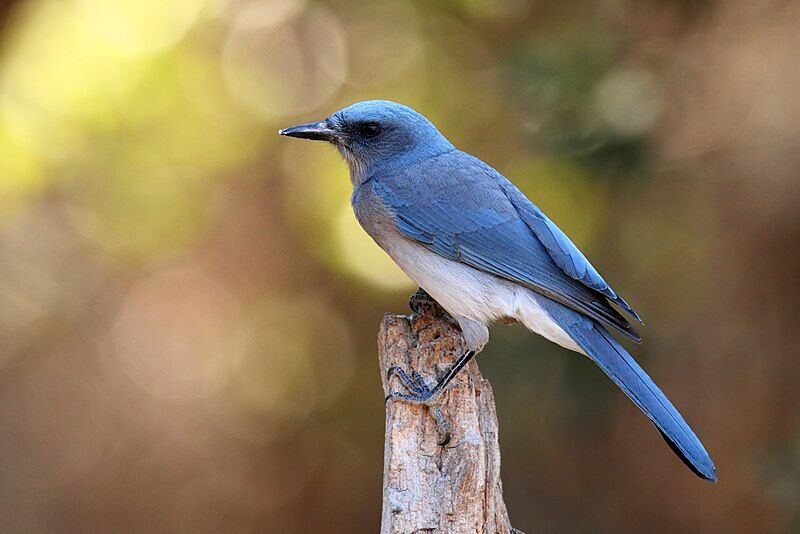
The Mexican Jay is a species of New World Jay that is native to Mexico and parts of the southwestern United States. It was formerly known as the Gray-Breasted Jay. This species can be found in the Sierra Madre Oriental, Sierra Madre Occidental, and Central Plateau of Mexico.
The Mexican Jay is a medium-sized bird, with a gray head, breast, and back. The wings and tail are black, with blue spots and bars, and the belly is white. The Mexican Jay is a social bird that lives in flocks of up to thirty individuals.
They are known to feed on fruits, nuts, and insects, and they also scavenge for food around human habitations. The Mexican Jay is an important species in its range, as it helps to disperse seeds and can act as a pollinator for certain plants.
| Kingdom | Animalia |
| Phylum | Chordata |
| Class | Aves |
| Order | Passeriformes |
| Family | Corvidae |
| Genus | Aphelocoma |
| Species | A. wollweberi |
Conclusion
Bluebirds are an important part of California wildlife. They are important to the environment, providing both ecological and aesthetic benefits. They are also a source of joy and wonder to many people, providing a beautiful sight and a delightful sound.
The bluebirds of California are a beloved part of the landscape, and their future should be safeguarded and protected.